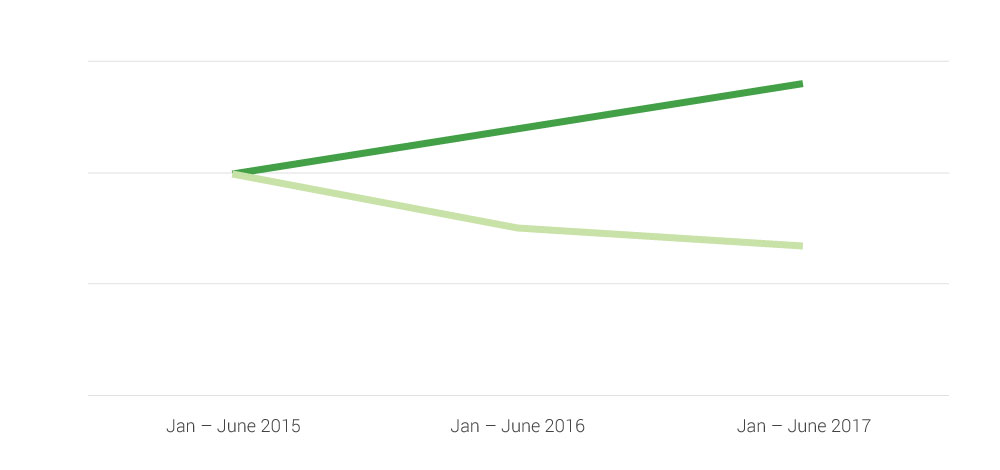Marketers can now infer location and interpret context. Google’s VP of Marketing for the Americas Lisa Gevelber explains why “near me” intent is a “near you” opportunity.
This summer has been a whirlwind of family visits and celebrations for me. And my favorite thing to do in a new town is discover local favorites—ideally the best coffee shop and the best local ice cream. In Champaign, Illinois, I discovered delicious Kaldi’s coffee at Harvest Market, and tried a super indulgent Cookie Dough Snowstorm at the more than 60-year-old Jarling’s Custard Cup. In Kansas City, Missouri, I discovered The Rieger Hotel’s restaurant, where a giant tray of grilled veggies delivered smiles to the entire group. And I discovered all of these places using my phone.
Location matters more, yet is stated less
Looking for something nearby—a coffee shop, noodle restaurant, shoe store—is one of the most common searches we do. In fact, nearly one-third of all mobile searches are related to location [download].1
In September 2015, we shared that “near me” or “nearby” searches on Google had grown 2X in the previous year.2 Now, just two years later, we see that behavior has continued to change. Make no mistake, people still use ”near me” to discover places of interest around them. But we're now seeing a shift toward dropping location qualifiers (like zip codes, neighborhoods, and “near me” phrasing) in local searches, because people know that the results will automatically be relevant to their location—thanks to their phone. It’s kind of magical. In fact, this year, search volume for local places without the qualifier “near me” has actually outgrown comparable searches that do include ”near me [download]."3 Over the last two years, comparable searches without "near me" have grown by 150% [download].4

Let’s consider a specific category of searches with high local intent: restaurants. Zip code qualifiers (“Mexican restaurants 94939”) are fairly common. But over the past two years, while restaurant-related searches have grown by double digits [download], those same searches that include a zip code qualifier have declined by over 30%.5 More evidence that local relevance is expected, but not always overtly requested.
Restaurant searches with and without zip codes

-
Restaurant Queries
-
Restaurant Queries with Zipcodes
This expectation plays out in other ways, too, like when people perform context-free searches such as “is it going to rain today.” Of course it’s never been necessary to qualify what day “today” refers to, but do they mean the weather in San Francisco, Sydney, or Shanghai? That piece is personal. It’s unique to that individual’s place and time. Once again, people increasingly expect to get results that are tailored accordingly—without the need to spell out their request. Searches for “is it going to rain today” have grown steadily [download].6 On the other hand, searches for “Houston weather forecast,” as an example, have shown a more stable pattern.
Search interest in "Is it going to rain today" vs. "Houston weather forecast"

-
"Is it going to rain today"
-
"Houston weather forecast"
Inferring and interpreting context will be key
The trends are clear, and we as marketers need to take notice. People may be sharing less, but they still expect relevant, accurate information. In fact, people increasingly assume they’ll receive relevant information with fewer explicit inputs. They expect a simple word or phrase to deliver the results they’re after when they search. In essence, people are saying “don’t make me exert extra effort when you should already know exactly what I want.”
Marketers who have been accustomed to getting explicit requests from their customers now need to infer and interpret these critical signals. The brands willing to go that extra mile can expect to see results: Nearly two-thirds of smartphone users are more likely to purchase from companies whose mobile sites or apps customize information to their location [download].7 A focus on capturing and using as much contextual information as possible will be key to really understanding people and delivering on their expectations.







